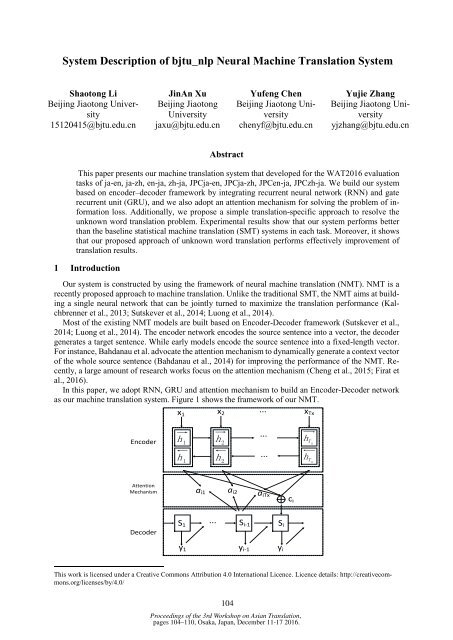December 11-16 2016 Osaka Japan
W16-46
W16-46
You also want an ePaper? Increase the reach of your titles
YUMPU automatically turns print PDFs into web optimized ePapers that Google loves.
System Description of bjtu_nlp Neural Machine Translation System<br />
Shaotong Li<br />
Beijing Jiaotong University<br />
15120415@bjtu.edu.cn<br />
1<br />
JinAn Xu<br />
Beijing Jiaotong<br />
University<br />
jaxu@bjtu.edu.cn<br />
Yufeng Chen<br />
Beijing Jiaotong University<br />
chenyf@bjtu.edu.cn<br />
Yujie Zhang<br />
Beijing Jiaotong University<br />
yjzhang@bjtu.edu.cn<br />
Abstract<br />
This paper presents our machine translation system that developed for the WAT20<strong>16</strong> evaluation<br />
tasks of ja-en, ja-zh, en-ja, zh-ja, JPCja-en, JPCja-zh, JPCen-ja, JPCzh-ja. We build our system<br />
based on encoder–decoder framework by integrating recurrent neural network (RNN) and gate<br />
recurrent unit (GRU), and we also adopt an attention mechanism for solving the problem of information<br />
loss. Additionally, we propose a simple translation-specific approach to resolve the<br />
unknown word translation problem. Experimental results show that our system performs better<br />
than the baseline statistical machine translation (SMT) systems in each task. Moreover, it shows<br />
that our proposed approach of unknown word translation performs effectively improvement of<br />
translation results.<br />
1 Introduction<br />
Our system is constructed by using the framework of neural machine translation (NMT). NMT is a<br />
recently proposed approach to machine translation. Unlike the traditional SMT, the NMT aims at building<br />
a single neural network that can be jointly turned to maximize the translation performance (Kalchbrenner<br />
et al., 2013; Sutskever et al., 2014; Luong et al., 2014).<br />
Most of the existing NMT models are built based on Encoder-Decoder framework (Sutskever et al.,<br />
2014; Luong et al., 2014). The encoder network encodes the source sentence into a vector, the decoder<br />
generates a target sentence. While early models encode the source sentence into a fixed-length vector.<br />
For instance, Bahdanau et al. advocate the attention mechanism to dynamically generate a context vector<br />
of the whole source sentence (Bahdanau et al., 2014) for improving the performance of the NMT. Recently,<br />
a large amount of research works focus on the attention mechanism (Cheng et al., 2015; Firat et<br />
al., 20<strong>16</strong>).<br />
In this paper, we adopt RNN, GRU and attention mechanism to build an Encoder-Decoder network<br />
as our machine translation system. Figure 1 shows the framework of our NMT.<br />
...<br />
x 1<br />
x 2<br />
x Tx<br />
Encoder<br />
h 1<br />
h 2<br />
...<br />
h Tx<br />
h 1<br />
h<br />
2<br />
...<br />
h T x<br />
Attention<br />
Mechanism<br />
a i1 a i2 a iTx<br />
c i<br />
Decoder<br />
S 1<br />
... S i-1 S i<br />
y 1 y i-1 y i<br />
This work is licensed under a Creative Commons Attribution 4.0 International Licence. Licence details: http://creativecommons.org/licenses/by/4.0/<br />
104<br />
Proceedings of the 3rd Workshop on Asian Translation,<br />
pages 104–<strong>11</strong>0, <strong>Osaka</strong>, <strong>Japan</strong>, <strong>December</strong> <strong>11</strong>-17 20<strong>16</strong>.



